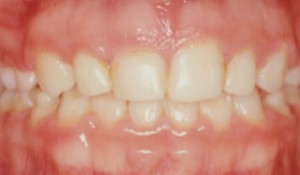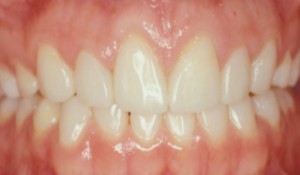Expose more of the tooth to enable
further restoration and/or improve aesthetics
Crown Lengthening
Crown lengthening is a surgical procedure that shapes and recontours the gum tissue and bone tissue around a tooth allowing more of the natural, healthy tooth to be exposed.

Esthetic Crown Lengthening (Before)

Esthetic Crown Lengthening (After)
Reasons for crown lengthening
There are many different reasons to undergo crown lengthening.
Patients who have a “gummy” smile may choose to have crown lengthening as part of a cosmetic procedure. Removing excess gum tissue can restore a balanced, healthy look and thus improve the aesthetic appearance of the smile.
Periodontal disease can cause severe damage to the teeth, as can trauma and decay. Sometimes a tooth breaks below the gum line and crown lengthening can be used to prepare the area for a new restoration to correct the damaged teeth.
Crown lengthening is also performed as part of a treatment plan for a tooth that is to be fitted with a crown. Crown lengthening provides more space between the supporting jawbone and dental crown. This prevents the new crown from damaging gum tissues and bone once it is in place.
What to expect with crown lengthening
Crown lengthening is normally performed under local anesthetic. The amount of time this procedure takes will largely depend in how many teeth are involved and whether a small amount of bone needs to be removed, in addition to the soft tissue. Any existing dental crowns will be removed prior to the procedure, and replaced immediately afterwards.
Dr. Tymkiw will make a series of small incisions around the soft tissue in order to separate the gums away from the teeth. Even if only one tooth requires the re-contour, neighboring teeth are usually treated to provide a more even reshaping. Separating the gums access to the roots of the teeth and the underlying bone.
In some cases, the removal of a small amount of tissue will provide enough tooth exposure to place a crown. In other cases, you may need a small amount of bone from around the teeth removed. After surgery your teeth will look noticeably longer immediately because the gums have now been repositioned.
The surgical site will be secured using an intraoral (periodontal) bandage, which serves to prevent infection. Prescriptions may be provided for pain medication, and a chlorhexidine (antimicrobial) mouth rinse may be given to help reduce any bacteria attempting to re-colonize. The surgical site will be completely healed in approximately two to three months.
You may experience some swelling after the surgery. Applying an ice pack to the outside of your face over the treated area can help with any discomfort. In some cases, antibiotics are given before, during, and after the treatment in order to prevent any infections. After a week or two, you’ll have a post-op check where Dr. Tymkiw will check the surgical area and make sure you are healing well and address any questions you may have.
Refer to Post Surgical Instructions for aftercare recommendations.


